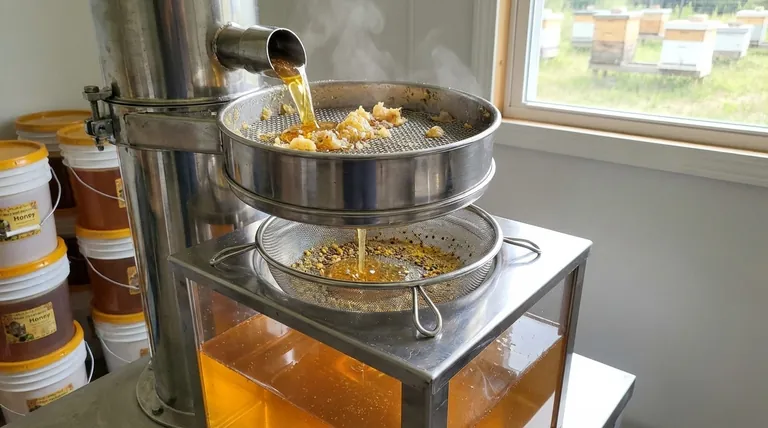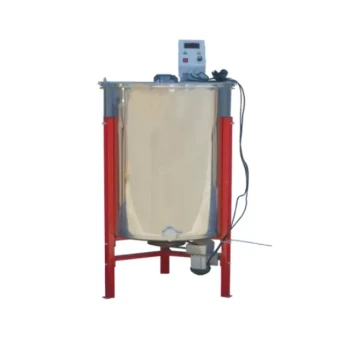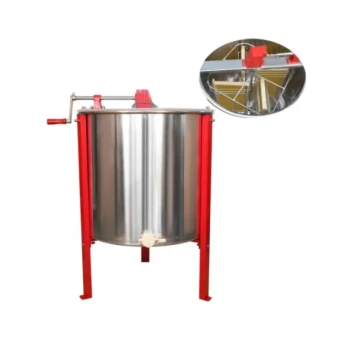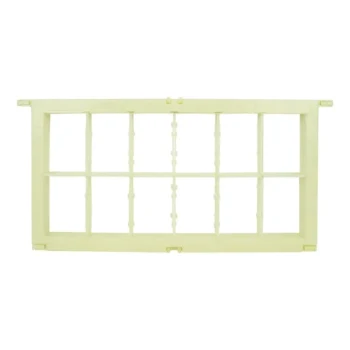At its core, a honey filtering machine clarifies honey through a systematic process of gentle heating and multi-stage physical filtration. This process is designed to remove a wide range of visible and microscopic impurities, from wax and bee parts to fine sugar crystals and air bubbles, resulting in a visually clear, stable, and marketable final product.
The primary function of a honey filtering machine is not just to improve appearance, but to fundamentally enhance the honey's quality and shelf stability. It achieves this by removing the physical impurities that act as catalysts for unwanted crystallization and fermentation.

The Core Filtration Process: From Raw to Refined
A honey filtering machine standardizes the purification process, turning raw, harvested honey into a consistent, shelf-ready product. This is accomplished through a few key mechanical stages.
The Role of Gentle Heating
Before any filtering occurs, the raw honey is often gently heated in a holding tank. The purpose of this step is twofold: it lowers the honey's viscosity (making it flow more easily) and dissolves any small sugar crystals that have already formed. This ensures the honey can pass through the filters smoothly and efficiently without clogging the system.
Multi-Stage Straining
The heart of the process is a series of progressively finer mesh screens or filters. The honey is passed through these stages in sequence.
- Coarse Filters remove the largest debris, such as wax cappings, splinters from the hive, and bee parts.
- Fine Filters then trap smaller particulate matter, including pollen grains, dust, and fine sugar crystals that would otherwise make the honey appear cloudy.
Removing Trapped Air
During extraction and pumping, air bubbles can become incorporated into the honey. A filtering system helps release these bubbles. Removing this trapped air is critical because it reduces the risk of oxidation and fermentation, thereby preserving the honey's freshness and flavor.
The Function of Pressure Systems
Some advanced machines incorporate a pressure system. This doesn't change the nature of the filtration but significantly increases its speed and efficiency, which is vital for commercial operations processing large volumes of thick honey.
Key Benefits of Mechanical Filtration
Filtering is a critical quality control step that goes far beyond simple aesthetics. It directly impacts the commercial viability and longevity of the product.
Achieving Visual Clarity and Consistency
The most immediate benefit is a perfectly clear, brilliant product that consumers often associate with high quality. By removing all suspended particles, the machine ensures a consistent appearance from batch to batch, which is essential for brand trust.
Extending Shelf Life
Impurities and trapped air can introduce moisture and microorganisms that lead to fermentation and spoilage. By creating a purer honey, filtration effectively removes these potential contaminants, significantly extending the product's shelf life.
Preventing Unwanted Crystallization
Crystallization is a natural process, but it can be accelerated by impurities. Tiny particles of pollen, dust, or wax act as nucleation sites—points where sugar crystals can begin to form. Removing these particles dramatically slows the rate of crystallization, keeping the honey in a liquid state for much longer.
Understanding the Trade-offs
While filtration provides significant benefits for commercial honey, it's crucial to understand the trade-offs, particularly concerning the definition of "raw" honey.
The Pollen Debate
The primary debate centers on pollen. While pollen can contribute to cloudiness and act as a nucleation site for crystals, many consumers seek it out for its perceived health benefits.
Ultra-fine filtration, often used in large-scale commercial packing, can remove the majority of pollen from honey. This results in a product that some purists would no longer consider "raw" or "whole."
Balancing Purity and Natural Qualities
The decision of how much to filter is a strategic one. There is no single "correct" method; it depends entirely on your product goals and target market. The choice is between the stability and clarity of highly filtered honey and the natural character of minimally strained honey.
Making the Right Choice for Your Goal
Your filtration strategy should be a deliberate choice based on how you intend to market your honey.
- If your primary focus is commercial retail: Employ fine filtration to ensure maximum shelf life, visual clarity, and delayed crystallization for a broad consumer audience.
- If your primary focus is the "raw" or artisanal market: Use only coarse straining to remove large debris (like wax and bee parts) while intentionally preserving the natural pollen, enzymes, and character of the honey.
Ultimately, understanding the mechanics of filtration empowers you to produce honey that precisely matches your quality standards and brand promise.
Summary Table:
| Process Stage | Key Function | Benefit to Honey |
|---|---|---|
| Gentle Heating | Lowers viscosity, dissolves crystals | Ensures smooth flow, prevents clogging |
| Multi-Stage Filtration | Removes wax, bee parts, pollen, dust | Achieves visual clarity, removes nucleation sites |
| Air Bubble Removal | Releases trapped air | Reduces oxidation and fermentation risk |
| Pressure Systems (Optional) | Increases flow speed | Enhances efficiency for large volumes |
Ready to produce clearer, more stable, and market-ready honey?
For commercial apiaries and distributors, the right filtration equipment is key to maximizing product quality, consistency, and profitability. HONESTBEE supplies durable, high-performance honey filtering machines and a full range of beekeeping supplies designed for wholesale operations.
Contact our experts today to discuss the best filtration solution for your honey production goals and volume needs.
Visual Guide

Related Products
- Stainless Steel Triangle Support Honey Strainer and Filters
- Honey Concentrating and Filtering Dehumidifier Machine 2T Capacity for Honey
- HONESTBEE 72 Frame Industrial Electric Honey Extractor for Beekeeping
- Electric 8 Frame Honey Spinner Extractor Equipment for Beekeeping
- Stainless Steel Manual 8 Frame Radial Honey Extractor Machine for Beehives
People Also Ask
- What is the easiest way to strain honey? A Simple Guide for Hobbyist Beekeepers
- What methods are used for straining honey? Choose the Right Method for Your Scale
- What are the benefits of using a honey filtering machine? Boost Purity, Efficiency & Market Appeal
- Why is filtering important in honey processing, and what equipment is used? A Guide to Quality & Efficiency
- Should honey be filtered or unfiltered? Maximize Health Benefits with Raw Honey



















